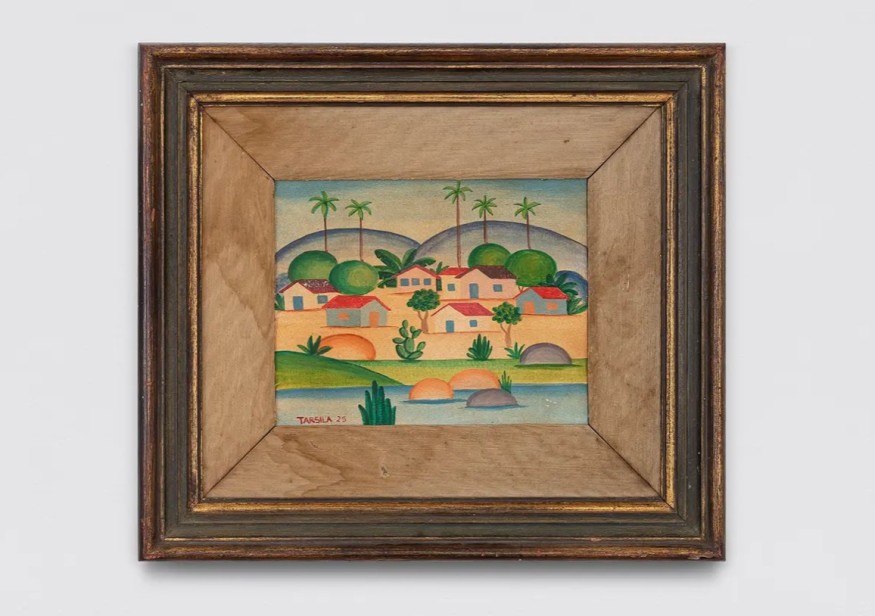Brazilian Auction House Founder Disputes Alleged Forgery of Tarsila Do Amaral Painting

Amidst the swirling controversy engulfing the untitled painting attributed to Brazilian luminary Tarsila do Amaral, São Paulo's esteemed art event, SP Arte, is ensnared in a web of speculation and doubt. Jones Bergamin, the formidable figure presiding over Bolsa de Arte, Brazil's esteemed auction house, unequivocally dismissed the artwork as a forgery despite never scrutinizing it firsthand. Bergamin's resolute declaration, featured in Folha de S.Paulo, likened the disputed painting to a phantom three-dollar bill, a testament to his unwavering skepticism.
Counterargument
For having the opposite opinion, Thomaz Pacheco, a visionary behind the OMA Galeria, appears to be the gallerist who has been bravely accused of Bergamin and strongly rejects Bergamin's allegations. Pacheco's keen eye did not rely on mere statements; he claimed that only a private and detailed inspection could prove the painting's authenticity and possibly fool those who doubted its veracity without meeting it in reality.
The Private Showcase
Through the twist of fate, the mysterious artwork was remarkably missing from the star-studded SP Arte fair. Their occurrence happened privately to show it to the carefully selected potential buyers. Although the painting was presented silently, the selling price - before any argument - was a huge $3.2 million, which could only have strengthened Bergamin's doubts. The auctioneer argued this by illustrating that the price tag stated should be considered a bargain in case it turns out to be an authentic work and drew inspiration from the $11.2 million brought by a previous do Amaral sale in December 2020 as a reference.
In the wake of the ensuing fracas, SP Arte swiftly distanced itself from the unfolding debacle, affirming its commitment to international standards of scrutiny. The event organizers underscored the rigorous vetting process by exhibitors, clarifying that the contentious artwork did not grace the fair's walls nor feature in its sanctioned projects, thereby absolving SP Arte from culpability in the unfolding saga.
Expert Analysis
However, this was the case for Douglas Quintale, a mature connoisseur of art from Sao Paulo, as he solemnly drew close to the masterpiece for a more exacting critique. Nonetheless, not eager to be hasty and jump to definite conclusions, he has stated that evaluating each fact and case thoroughly before affecting any final judgment about its authenticity is necessary. Just like the art world itself, as the artist's estate and Pacheco are impatiently and probably nervously awaiting the outcome from the meticulous testing, which marks the beginning of the 90 days to determine the truth, this valuable piece will bring.
When there is chaotic noise of multiple voices and uncertainties, the future of the contested work is put at high risk and dangling. The story of this defraud is undoubtedly the one that leaves one anxious. It is a grim reminder of the complex intricacies and myriad of risks that make up the world of art authentication, thus leaving the world of art in limbo as it waits for this investigation's dramatization.
Related Article : 10 Art Museums and How They Outrank Big Businesses in Reputation
From Digital Models to 3D-Printed Homes: Jaspreet Kaur Lall Explains How the Innovation Changes the Construction Industry

Future Belongs to Green Construction: Sampath Kumar Paspunoori Explains One of the Key Trends in the Construction Industry

Kamala Harris' Campaign Ad Uses Iconic Visuals from Carrie Mae Weems to Connect with Voters

Historic Ancient Roman Ruins in Baalbek Remain Strong After Israeli Air Strikes; Locals Seek Cultural Protection

4 Ways to Honor Departed Loved Ones in Your Home Design









